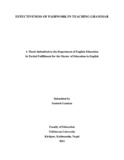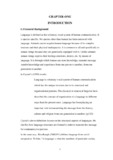Please use this identifier to cite or link to this item:
https://elibrary.tucl.edu.np/handle/123456789/914| Title: | Effectiveness of Pairwork in Teaching Grammar |
| Authors: | Gautam, Santosh |
| Keywords: | Pairwork;Teaching Grammar;Effectiveness |
| Issue Date: | 2011 |
| Publisher: | Department of Education English |
| Institute Name: | Central Department of Education |
| Level: | Masters |
| Abstract: | This study entitled “Effectiveness of Pairwork in Teaching Grammar” aims at determining pairwork technique’s effectiveness in teaching grammar. The main objective of this research is to find out the effectiveness of pairwork technique in teaching tense in grade nine. Thirty student of grade nine studying at Shree Suryodaya Secondary School, Gulmi, were the sample population of this work. The researcher was involved in the experimental teaching for the purpose of carrying out the research. The test (pre-test and post test)were the major tools for data collection. A pre-test was administered before actual class room teaching and a post-test was administered immediately after classroom teaching. The students were ranked from first to the thirtieth position on the basis of the results of the pre test. They were divided into two groups on the basis of odd-even ranking of individual scores. Then, one group (Group A) was taught through pairwork technique whereas another group (Group B) was taught through lecture technique. Each attended twenty eighth lessons. Then a post test was taken. After that the results of these two tests were compared to determine the effectiveness of pairwork technique in teaching tense. The findings of the study showed that pairwork technique is the motivating and effective technique in the field of English tense teaching. Chapter one consists of brief introduction of related area of the study. It includes objectives, significance of the study and definition of specific terms. Chapter two deals with the methodology adopted during the study. Chapter three consists of analysis and interpretation of the data. The data have been mainly analyzed and interpreted on the basis of difference between the average score (in percentage) of each group in the pre-test and post test. The group with a higher increment (in percentage) has been considered better. The analysis has been done under the following categories:1) Holistic comparison 2) Item wise comparison. Chapter four comprises findings and recommendations of the study. |
| URI: | http://elibrary.tucl.edu.np/handle/123456789/914 |
| Appears in Collections: | English Language Education |
Files in This Item:
| File | Description | Size | Format | |
|---|---|---|---|---|
| cover.pdf | 35.91 kB | Adobe PDF |  View/Open | |
| CHAPTER(1).pdf | 95.07 kB | Adobe PDF |  View/Open |
Items in DSpace are protected by copyright, with all rights reserved, unless otherwise indicated.
